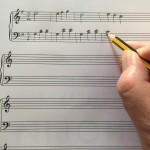 A lead sheet shows the essential elements of your song: lyrics, melody, and harmony. It is the basic work of a composer. The melody’s notes are written on a single staff of music, the lyric’s words are written below the staff, and the harmony’s chords symbols are written above the staff. A lead sheet doesn’t show the accompaniment, though.
A lead sheet shows the essential elements of your song: lyrics, melody, and harmony. It is the basic work of a composer. The melody’s notes are written on a single staff of music, the lyric’s words are written below the staff, and the harmony’s chords symbols are written above the staff. A lead sheet doesn’t show the accompaniment, though.
A vocal score shows the accompaniment, in addition to the essentials. It is the work of an arranger, a role the composer often fills. The information from the lead sheet appears on the upper (treble) staff, and the accompaniment appears on the lower (bass) staff directly below. It is used by singers for rehearsal (and sometimes performance) with a keyboard.
A full score shows the essentials and accompaniment, with a separate staff for each instrumental and vocal line. It is the work of an orchestrator, a role the composer sometimes fills. A full score is used by conductors for performance with an instrumental ensemble.
So, what is accompaniment? It is the rhythmic and harmonic support for your melody. It shows the beat of the music and the details of your chord progressions. This can be as simple as writing three-note triad chords or as complex as creating arpeggiated chords, a walking bassline, or chord progression motifs (riffs).
To find an accompaniment for your song, start with different percussion and sound effects, like clapping, beat boxing, or electronic loops. If you don’t have access to an instrument or software, consider an a cappella accompaniment, using only your actors’ voices.
A cappella has been a staple of pop music from barbershop quartets to doo-wop groups. For inspiration, listen to Bobby McFerrin (particularly “Don’t Worry, Be Happy”), Naturally Seven, Pentatonix, Rockapella, and The Swingles. For examples of stage and screen a cappella, look for the TV series The Sing-Off (2009), which featured Pentatonix, as well as the Pitch Perfect films and the stage musicals Avenue X (1994) and In Transit (2010), the first a cappella musical on Broadway.
For accompaniment examples, check your local library’s e-book and audiobook services for The Definitive Broadway Collection (2003) published by Hal Leonard or download the first volumes of the publisher’s two series based on Stanley Green’s stage and screen histories: Broadway Musicals Show by Show and Hollywood Musicals Year by Year.
To hear some of those songs, stream Ultimate Broadway (1998). For a wider selection, look for Smithsonian’s four-album American Musical Theater (1898-1964) or binge on Pearl’s four-volume Music from the New York Stage (1890-1920) plus Decca’s six-album Broadway: America’s Music (1935-2005).
Finally, for a composer’s insight, read Enchanted Evenings (1997) by Geoffrey Block or The Joy of Music (1959) by Leonard Bernstein. To learn about Broadway’s major composers, look for Show Tunes (2010) by Steven Suskin.
Vocabulary from this week: chord, three or more pitches together; close vowel (high vowel), a vowel sound that partially blocks airflow; downbeat, the strongest beat of a phrase; harmony, the secondary pitches of a song; melody, the primary pitches of a song; progression, the pattern of chord changes; rhythm, the movement of a song; root (key), the main pitch of a chord or a whole song; stop consonant (plosive consonant), a consonant sound that blocks airflow; and tension (dissonance), pitches that clash.
For inspiration, watch Raúl Esparaza host Take Me to the World: A Sondheim 90th Birthday Celebration from April 26, the 50th anniversary of Company. (Sondheim’s birthday was March 22.) The concert includes Sondheim veterans Meryl Streep, Bernadette Peters, Patti LuPone, Audra McDonald, and Donna Murphy, as well as Mandy Patinkin, Christine Baranski, Kristin Chenoweth, Sutton Foster, Brian Stokes Mitchell, Kelli O’Hara, Aaron Tveit, Katrina Lenk, Michael Cerveris, Brandon Uranowitz, Stephen Schwartz, and Chip Zien.
Next, rehearsals and readings.
